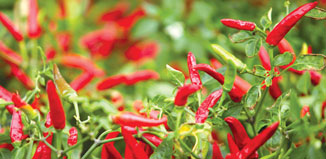Hot is the operative word for these super-charged veggies, in looks, taste and growth requirements.
Chillies come from the same species (capsicum annum) as sweet peppers, and are kin to tomatoes, aubergines, potatoes and tamarillos. To produce their fiery heat and fine flavour, they need to be grown in the heat of summer, and allowed to mature through a long, fine autumn.
If you’re planning to grow chillies from seed, sow in trays or pots and place in a warm spot – they require temperatures of at least 15deg C to germinate (like most other plants, chilli seeds need warmth, oxygen and moisture before germination can occur).
Anything you can do to increase heat aids their subsequent growth, including covering them with cloches or surrounding them with heat-absorbing rocks.
When the soil and weather is reliably warm, plant your chillies, 30cm apart, in fertile, free-draining soil. Don’t over-burden soil with fresh nitrogen – too much nitrogen produces excess foliage at the expense of fruit, and makes plants susceptible to disease.
Pick a warm spot that receives full sun for at least half the day, and feed regularly with liquid fertiliser to ensure steady, disease-resistant growth.
Chilli plants are compact, but because of their shallow root system need support – put a stake in when transplanting. They also need regular watering to produce quality fruit, but are pretty tough once established, and can tolerate dry conditions provided they have periodic deep watering.
Soil that stays wet for long periods can bring on root-rot, and may also lead to fruit having a bitter taste, and plants grown in constantly dry soil will produce smaller crops of under-sized fruit. Mulching with a weed-free product, such as pea straw pellets, will help maintain soil moisture.
Regular harvesting of chillies encourages more fruit to grow, so make sure you pick early and often. When you’ve picked the summer crop, prune plant to at least half their size – this helps the chilli survive over winter.
Chillies are eaten in almost every culture, and there are hundreds of varieties around the world, ranging from mild to the exceedingly hot, such as ‘Habanero Red’, which has a colour to match the flavour – a variety for the true chilli aficionado!
A pungent yet mild variety is ‘Anaheim’ which ripens to a deep scarlet, but can also be used when still green if fully formed.
If you’re interested in drying your chillies, ‘Asian Fire’ is hot and spicy, can be used in both its unripe and ripe form, and is an excellent variety for stringing up, drying, then grinding into your own chilli powder.
Chilli plants are an attractive addition to either the ornamental or vegetable garden, and with their glossy leaves, white, star-shaped flowers and first green, then deep red fruit, look good enough in pots to grace the sunniest spot on your deck or porch – but keep way from little fingers.

